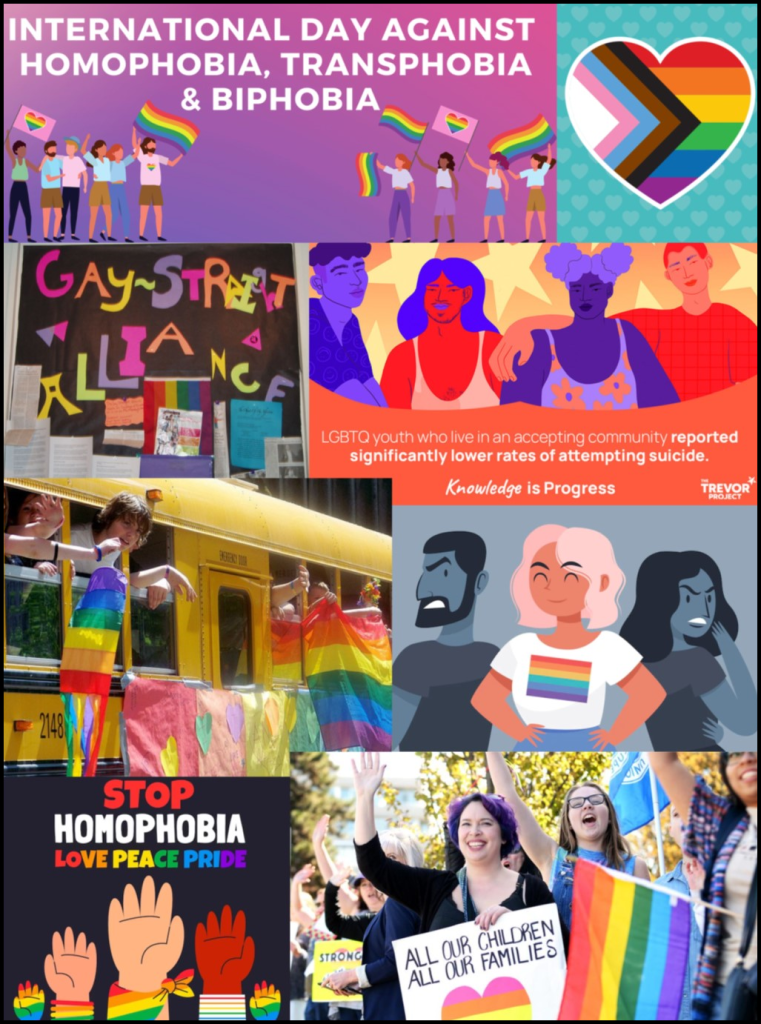5 2SLGBTQ+ Rights

By Julia Amaral
Over the years, society has become more accepting of 2SLGBTQ+ people; however, homophobia is still a prevalent issue. Homophobia is often conveyed through jokes rather than direct comments, which are equally harmful (Queen Mary University of London, n.d.). When I was in high school, I constantly heard people making discriminatory comments or jokes about the 2SLGBTQ+ community. Hearing these comments multiple times a day, every day, for years, negatively affected my self-image as my mother identifies as lesbian, and I was confused about my identity. I used the collage to reflect on my experiences through this challenging time in my life. I included an image on the top stating the international day against homophobia, transphobia, and biphobia, as I felt it was necessary to spread awareness.
To stand up to homophobia, transphobia, and biphobia means recognizing the importance of creating inclusive and safe spaces for everyone without discriminating based on gender expression/identity or sexual orientation (Government of Canada, 2022). An example of one way to promote inclusivity in education for 2SLGBTQ+ people would be to create a GSA (Gay-Straight Alliance). GSAs and anti-homophobia policies implemented in schools create a lower risk of suicidal attempts and ideations in homosexual and heterosexual students (Saewyc et al., 2014). I included an image from the Trevor Project, a suicide prevention non-profit organization focused on assisting 2SLGBTQ+ youth, to create awareness of the issue. I have also included photos of GSAs and students/parents supporting 2SLGBTQ+ rights. Baams & Russell (2021) state that several studies have concluded that schools with GSAs create a welcoming environment and assist student adjustment. Schools must enforce anti-homophobia policies and create safe spaces (i.e. GSAs) to improve the mental health, well-being, and safety of 2SLGBTQ+ students (Baams & Russell, 2021; Saewyc et al., 2014).
References
Baams, L., & Russell, S. T. (2021). Gay-Straight alliances, school functioning, and mental health: Associations for students of color and LGBTQ students. Youth & Society, 53(2), 211–229. https://doi.org/10.1177/0044118×20951045
Government of Canada. (2022, June 29). Standing against homophobia, transphobia and biphobia. Statistics Canada. https://www.statcan.gc.ca/o1/en/plus/1294-standing-against-homophobia-transphobia-and-biphobia
Queen Mary University of London. (n.d.). What is homophobia, transphobia, biphobia and acephobia? Report and Support. https://reportandsupport.qmul.ac.uk/support/what-is-homophobia-transphobia-biphobia-a Nd-acephobia
Rodrigues, A. (2022). 2SLGBTQIA+ inclusion. OTU Canvas. https://learn.ontariotechu.ca/courses/19610/pages/2slgbtqia+-inclusion?module_item_id=470725
Saewyc, E., Konishi, C., Rose, H., & Homma, Y. (2014). School-based strategies to reduce suicidal ideation, suicide attempts, and discrimination among sexual minority and heterosexual adolescents in western Canada. International Journal of Child, Youth and Family Studies, 5(1), 89–112. https://doi.org/10.18357/ijcyfs.saewyce.512014
Victoria State Government. (2022, October 11). Homophobic behaviour. Victoria State. Government Department of Education. https://www.education.vic.gov.au/about/programs/bullystoppers/Pages/advicehomophobia.aspx

